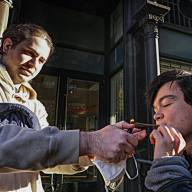 Filmmaker James Gray (“We Own the Night,” “Two Lovers”) reunites with Joaquin Phoenix for the 1920s drama “The Immigrant.”
Filmmaker James Gray (“We Own the Night,” “Two Lovers”) reunites with Joaquin Phoenix for the 1920s drama “The Immigrant.”
Credit: Getty Images
It’s really easy to lose track of time and focus when talking to James Gray. The filmmaker is doing press for his fifth feature, “The Immigrant,” which is his fourth to star Joaquin Phoenix. (Other include “The Yards,” “We Own the Night” and “Two Lovers.”) But while noshing on M&Ms, we wind up mostly chit-chating about other movies: John Ford, William Wyler, Italian cinema, Orson Welles, plus fading New York, Ellis Island, even Philadelphia cheesesteaks. (On the eternal Pat’s and Geno’s debate: “I think I’m Pat’s. Actually, I think I’m Jim’s.”)
A half hour goes by and we’ve only tangentially spoken about “The Immigrant.” That’s not because we shouldn’t have: It’s a terrific and characteristically hypnotic melodrama about a Polish woman (Marion Cotillard) in 1921 who arrives in New York and finds herself bullied into working with a stranger (Phoenix) who deals in prostitution. It wears its inspirations on its sleeve, prompting talk of the things that inspired it, with no time for questions about his new film by itself. Here’s the stray things we talked about as our time burned:
On making a movie on small scales: “It’s a very strange thing to make a film, particularly this kind of movie. It would be different for something like, I don’t know, ‘Captain America’ or ‘Godzilla.’ There, the audience goes or it doesn’t go the first week, and that’s about what it is. But this kind of movie, you don’t really know what you have until 10 years later. And either it lasts or it doesn’t.”
On waiting for reevaluation: “I would say certainly the gratifying thing is they almost always get reevaluated and revised upward. But the frustrating thing is when they come out, the reaction is in some places very nice and in some places very ornery. So I suppose it would be great if you made a film that everyone loved and made a zillion dollars and then 20 years later, people still loved it. There’s only one movie that I can think of, in the history of cinema, that came out, got incredible reviews, made tons of money, won the Oscar, and 20 years later you still said it was a masterpiece. And there’s only one: ‘The Godfather.’”
What about “Gone With the Wind”?: “People make fun of it. Here’s what I think: The last time I saw it I thought the first half had some incredible stuff in it. Then the second half was a little weaker. It doesn’t have quite the same oomph. Having said that, amazing moments, incredible visual stuff in ways that people don’t remember. It’s amazing visually, but I’m talking narratively. Once the daughter comes in…”
 Marion Cotillard and Joaquin Phoenix try to eke by in 1921 New York City in “The Immigrant.”
Marion Cotillard and Joaquin Phoenix try to eke by in 1921 New York City in “The Immigrant.”
Credit: The Weinstein Company
On his films as portraits of a fading New York City: “The city is going away. I’m not so keen to romanticize New York from the ‘70s, which is when I grew up, because it was pretty bad. It was filled with blackouts and riots. Have you ever seen Bruce Davidson’s photographs of the subway from, like, 1980? All these films that I’ve made have been attempts to recreate my own past — trying to convey what New York meant to me. That was not dinner at Rockefeller center — or if it was you would view that as the most amazing night of your life. You could see the top of the World Trade Center from where I lived, and the city seemed like this amazing, distant place that’s only nine miles away. These movies are an attempt to reveal that part of New York that we don’t see much of.”
On what inspired him to make a film in the 1920s: “I had a number of photographs. My family’s pretty well chronicled. I wanted to convey the mood of those photographs. Then on my father’s side, his family came over in 1923, through Ellis Island. We have all the paperwork. We took my grandfather on a trip to Ellis Island when it first opened up in 1976. He walked in and burst into tears. It was my attempt to recreate the family history a little bit. Being in Ellis Island shooting that stuff is the happiest I’ve ever been making anything.”
 Marion Cotillard sets sail in “The Immigrant.”
Marion Cotillard sets sail in “The Immigrant.”
Credit: The Weinstein Company
On shooting in Ellis Island, which not even Francis Ford Coppola (with 1974’s “The Godfather Part II”) and Elia Kazan (with “America, America,” from 1963) could do:“Coppola and Kazan had a different set of problems. I know that Coppola offered to restore the Great Hall if they’d let him shoot there. But up until 1983 it was not restored. It was in terrible shape. The tiles were falling off, the paint was chipped. It was a hazard. You had to go in there with a hard hat. When I did this movie the place had already been restored.
“Having said that, it was extremely difficult. The place is open almost every day as a museum. They wouldn’t close it for us. So we had to shoot at night. So you have to shoot night for day. But that room has a capacity for 7,000 people. It’s the largest room ever. And it’s on the second floor, not the first. And you have 18 windows that are 25 feet high each, and you’ve got to blast day light through each of them. And it’s Ellis ISLAND. All of a sudden the task is massive.
“There was talk, considering the difficulty level, of doing a green screen thing. But I was like, ‘That would be the worst thing ever.’ But we ended up doing it. We had to dress the extras in New York, then take the ferry — with the dressed extras — across to Ellis Island at midnight. We had to feed them lunch, which would be 2 a.m. But where do you feed them, because there’s no kitchen? It was just a disaster.”
 James Gray chats with Marion Cotillard on the set of “The Immigrant.”
James Gray chats with Marion Cotillard on the set of “The Immigrant.”
Credit: The Weinstein Company
On 35 mm film prints: “There was one before I made some changes. I’m going to pay to make one because people haven’t thought about archiving digitally yet. Media crashes on hard drives. Try to play a floppy disk now. Film prints stay in tact. I’m my own archivist. I’ve made brand new, very beautiful prints of my first four films, and I have them in a vault. And I’m going to do it for this one too, and it’s going to cost me $50,000. But it’s totally worth it, because you’re talking about a long-term investment in the film itself.”
On digital versus film projection, which is how “The Immigrant” will be shown: “I like digital projection in some cases. Gone is the period where you and I would go to the movies and the movie would be out of focus. Gone is the hair. Remember the hair? But I would still prefer a pristine 35mm print projected absolutely correctly to digital. But that’s like saying I’d rather have the perfect life where I live to 106. It’s a fantasy now to have a perfectly projected 35mm print.”
On the missing reels of Orson Welles’ “The Magnificent Ambersons”: “You don’t want them to find it, in a perverse way, because maybe it will be disappointing. Maybe this whole movie we’ve built up as the greatest thing since sliced bread — maybe we’ll watch it and think, ‘You know what? The audience in Pasadena that night was right.’”
His “perverse” choice for favorite Orson Welles film: “Chimes at Midnight”
 Giulietta Masina (far left, next to Anthony Quinn) and the film “La Strada” were a major influence on James Gray’s “The Immigrant.”
Giulietta Masina (far left, next to Anthony Quinn) and the film “La Strada” were a major influence on James Gray’s “The Immigrant.”
Credit: Provided
On Italian cinema as an inspiration on “The Immigrant”: “To me, Italian cinema from 1945 to 1980 is the greatest stretch of national cinema in the history of the world. American and French movies are the overall winners in terms of cultural contributions. But Italian cinema is my favorite. You’re talking Rossellini, Fellini, Visconti, de Sica, Francesco Rosi, Dino Risi, Mario Bava, Elio Petri, Ettore Scola, up through Lina Wertmuller, really. There’s an expression of humanity in them. There’s a level of compassion and empathy for the characters depicted in these that is deeply moving to me. It’s very easy to see the degree from which I steal from Fellini’s ‘La Strada’ for this movie.”
On Marion Cotillard’s character being inspired, partly, by “La Strada” star Giulietta Masina: “There’s a bit of Giulietta Masina, but Giulietta Masina winds up playing almost exclusively simpletons. I had seen Marion as a combination of Giulietta Masina with a bit of Falconetti from a Dreyer film [“Passion of Joan of Arc”] and a bit of Lillian Gish — a kind of silent film movie actress. She has a strength too, a will. If you come closer she’ll kill you. I thought that was a kind of survival mode, which Masina doesn’t have.”
On an Italian film he doesn’t like: “I hate ‘Satyricon.’ It’s my least favorite Fellini movie. I know some people love it. I cant’ stand it. But I love ‘Toby Dammit.’”
Follow Matt Prigge on Twitter @mattprigge














